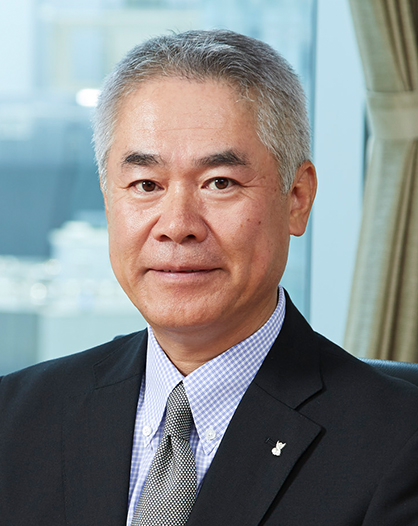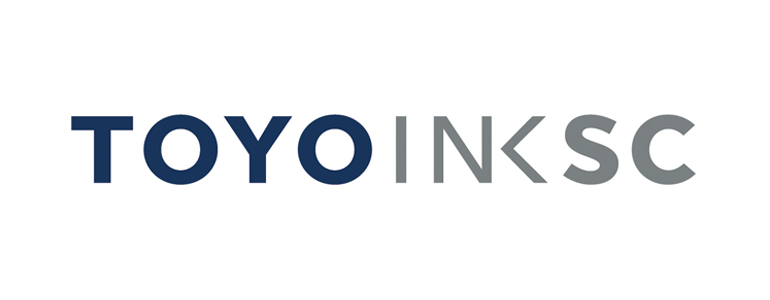| Toyo Ink SC Holdings, Co., Ltd. (4634) |
|
||||||||
Company |
Toyo Ink SC Holdings, Co., Ltd. |
||
Code No. |
4634 |
||
Exchange |
TSE 1st Section |
||
Industry |
Chemical (Manufacturing) |
||
President and CEO |
Katsumi Kitagawa |
||
Address |
3-7-1 Kyobashi, Chuo-ku, Tokyo |
||
Year-end |
End of March |
||
HP |
|||
* Share price as of closing on the end of June 19. Number of shares outstanding is as of quarter end from the most recent earnings briefing.
ROE and BPS are based on actual results of the previous term end. |
||||||||||||||||||||||||
|
|
* Estimates are those of the Company.
|
|
| Key Points |
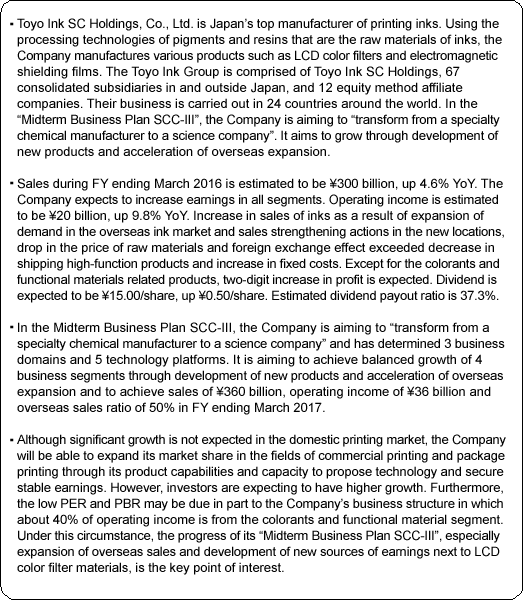 |
| Company Profile |
|
Initially, inks in the Japanese market were mostly imported products; however, as the national policy favored high quality domestically produced inks, the Company, with its advanced technological skills, successfully expanded its business with clients such as the Printing Bureau of the Ministry of Finance and other government bodies, in addition to private printing companies. Exports also grew during the same time. The Company's rapid growth was also due in part to the early introduction of integrated manufacturing system from raw materials (pigments, resins) to finished products (printing inks). Yet another contributing factor may be that the Company, since its inception, had strong ties with Toppan Printing Co., Ltd., which, by then, was among Japan's largest printing companies. The Company survived the difficult times of the Great Kanto Earthquake and the World War II and experienced rapid growth again during the period of high economic growth after the war. The Company was listed in the Second Section of the Tokyo Stock Exchange in 1961 and moved to the First Section of the Tokyo Stock Exchange in 1967. The Company is expanding its businesses from manufacturing of printing inks to other fields such as LCD film materials, using its wide range of technologies and know-how cultivated through manufacturing and processing of raw materials such as pigments and resins. In 2011, the Company adopted a holding company system for further expansion and growth of the Group, and changed its name to Toyo Ink SC Holdings, Co., Ltd. In April 2014, "improving shareholder satisfaction" was added to its guiding principles. With this revision, the Company is aiming to improve satisfaction of all stakeholders. 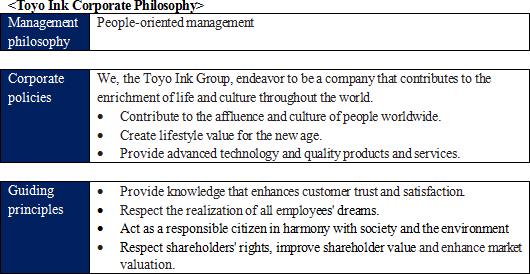 Furthermore, the "Toyo Ink Group Corporate Philosophy" is printed on the first page of every single issue of the Company's in-house magazine, which is published for the Group's unity and circulated to the entire Group including the overseas locations. Also the above-mentioned credo has "Japanese/English" version as well as "Chinese/English" version to share and penetrate the corporate philosophy globally. ◎ Overview (Market trend) In the realm of commercial printing, on the other hand, of posters, catalogues, fliers, POP, etc. demand is fairly steady. Furthermore, printing on food and pharmaceutical packages and plastic containers is steadily increasing at the compound annual growth rate (CAGR) of 3.4% from 2004 to 2014. 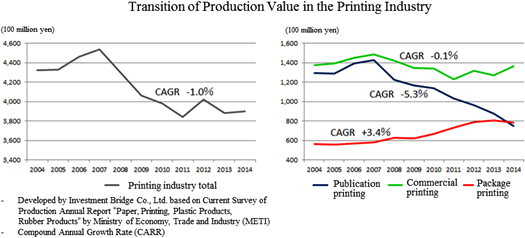 As innovation of printing machine is progressing, quality of printing is enhancing. Overseas local inks, in many cases, cannot respond to such demand for high quality, which may lead to more demand of excellent Japanese ink. (Printing houses and printing ink manufacturers)
According to the "Census of Manufactures 2013: Report by Industry" by METI, there were 27,026 business entities in the printing and related industries in 2013. 26,626 (98.5%) of them are small and medium-sized enterprises with fewer than 100 employees.
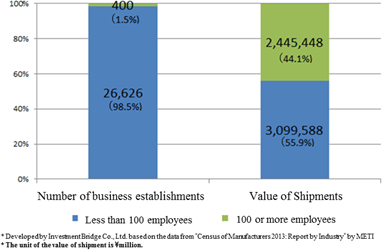 Thus, the Company's customers seek direct dealings with the Company. As a result, nearly 80% of the Company's domestic sales come from direct sales to its customers. These strong relationships with the customers are among the Company's major characteristics. ◎ Other companies in the industry
There are 6 major listed companies including Toyo Ink in the ink industry in Japan. Whereas (4631) DIC is the number one company in the world, Toyo Ink is the top runner in Japanese printing ink industry, and ranks first or second by most product categories. Globally, the Company is ranked third (The second is a European firm). (4633) SAKATA INX is the second largest shareholder of the Company. The Company and SAKATA INX complement each other mainly in logistical aspects. The two companies concluded a capital and business alliance agreement in 2000. The Company's operating income rate during the current FY is the highest among the 6 companies; however, its ROE is lower than that of DIC, and its PBR is less than 1.0x. 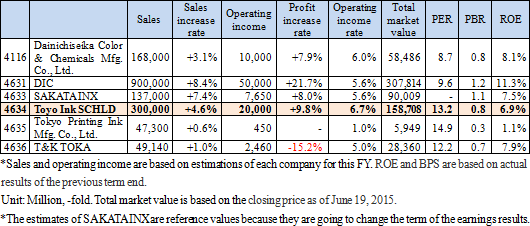 ◎ Concerning "printing inks"  Since its foundation, the Company also has been expanding its business categories by exploring application of these raw materials in the process of manufacturing them. 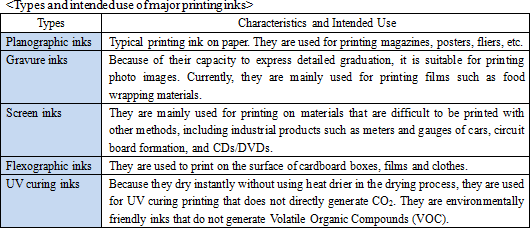 ◎ Business segments
The business activities of the Company are classified into 4 segments: the "Colorants & Functional Materials Related Business", "Polymers & Coatings Related Business", "Printing & Information Related Business", and "Packaging Materials Related Business".The "Printing & Information Related Business" mainly deals with planographic inks that are used for printing on papers (offset inks, etc.). The "Packaging Materials Related Business" deals with gravure inks and flexographic inks that are used for printing on films of food packages. The "Colorants & Functional Materials Related Business" deals with products related to pigments that are also the raw materials of printing inks as core materials. The "Polymers & Coatings Related Business" began with resins that are the main raw materials of inks and their design technologies. 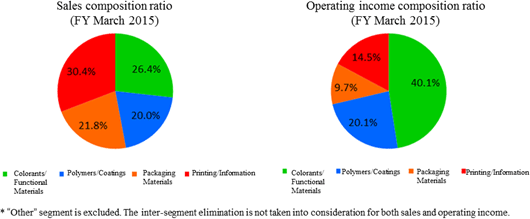 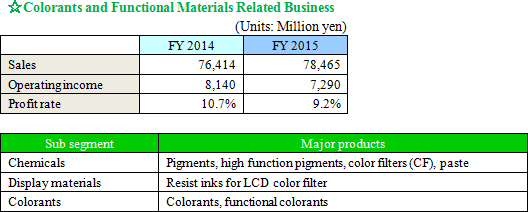 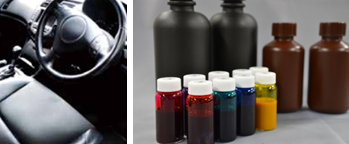 Furthermore, the Company's dispersion processing technologies are used not only for organic pigments but also inorganic materials such as carbon nanotube (CNT), which lead to expansion of their business in the new energy field such as secondary battery materials. They constitute about 40% of the Company's operating income.   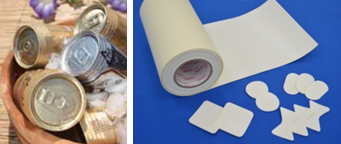 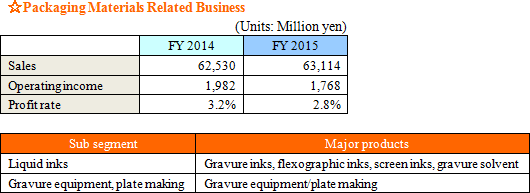 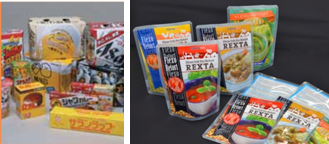 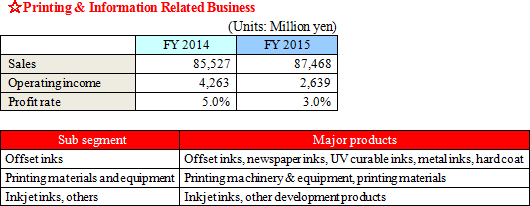 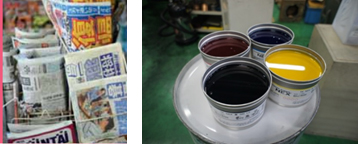 The Company offers not only printing inks but also sales of machinery/equipment, support for streamlining customers' printing process, and support and tools for color management and color universal design. ◎ Overseas expansion
While the Company is improving profitability by offering high-value-added products in the Japanese market, where a rapid growth is not expected, it is aggressively expanding its business from both production and sales perspectives in the overseas market where future growth is expected. Development of its overseas manufacturing structures were almost completed during the previous Midterm Business Plan, and the Company is carrying out both raw material procurement and production at the local sites. As of the end of March 2015, the Company has 49 overseas subsidiaries and 50 plants in 24 countries around the world.  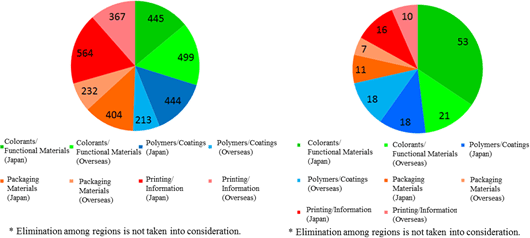  ROE is expected to increase by enhancing margin and efficiency (total asset turnover rate). (1) Strong technological edge (2) Excellent problem solving skills
One of the reasons for the Company to be at the top of the Japanese printing inks industry is its excellent problem solving capability in all aspects of printing. The Company not only produces and supplies printing inks but also studies elements related to "printing" as a whole including plate making and images. Such efforts enable the Company to make technological proposals, demonstrate advanced service skills, and obtain high customer satisfaction. (3) Environmental concerns
The Company is a forerunner in CO2 emission reduction as well as production of eco-friendly inks such as non-VOC inks, water-base inks, and UV inks. In the newly developed countries, too, the environmental regulations are becoming tighter, and the needs for environmentally friendly products are increasing. The Company is also working on assuring safety such as chemical substances control and manufacturing a line of products that meet the Swiss Ordinance, ahead of other companies.
(4) Uniqueness of management strategies
The Company considers M&A as one of the options for exploring new markets with its technological edge, if M&A is expected to bring synergy effects to the Company. It is also taking an initiative in the printing ink industry to establish "local production for local consumption" policy in the overseas market for enhancing efficiency (e.g. reduction in transport mileage) and social contribution (e.g. utilization of local products) purposes.
|
| Fiscal Year March 2015 Earnings Results |
 Decrease in profits due to increased price of raw materials, despite increase in sales.
Sales were ¥286.6 billion, up 2.5% YoY. All the segments recorded growth in sales. Operating income was ¥18.2 billion, down 7.7% YoY. Factors for profit increase such as price revisions for polymers and coating products and package related products and increase in profit of ¥0.7 billion due to depreciation of yen were exceeded by factors for decrease in profits. These factors for decrease included rise in material prices (¥2.2 billion), rise in fixed costs (¥0.6 billion) and fall in sales quantity (¥0.2 billion). Both sales and profits fell below the estimates at the beginning of the period.
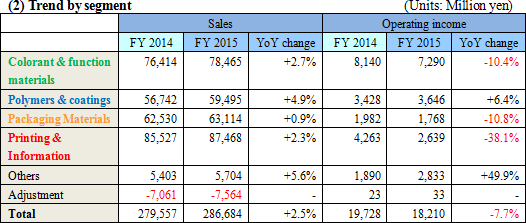 ☆Colorants and Functional Materials Related Business
The segment recorded an increase in sales and a decrease in profit.
<Chemical products>
Concerning general-purpose pigments, both printing inks and coating materials trended low due to the remaining effect of consumption tax hike in Japan. Overseas, on the other hand, sales increased as a result of expanded sales in Southeast Asia. Overall, profit decreased due to higher raw material prices caused by depreciation of yen.
<Display materials>
High function pigments and LCD color filter materials trended favorably in Taiwan and South Korea, and sales increased in China. In Japan, however, demand was weak and sales decreased. In the intensifying price competition of LCD panels, demand for cheaper parts further strengthened, which resulted in a decrease in profit.
<Colorants>
Sales of plastic colorants in Japan were adversely affected by consumption tax hike and bad weather. However, the market share of plastic colorants for containers expanded. Also in China, South Korea and Southeast Asia, sales of plastic colorants for containers and office equipment expanded. New products related to solar battery components also trended favorably. As a result, this segment recorded an increase in both sales and profit.
☆Polymers & Coatings Related Business
This segment recorded an increase in both sales and profit.
<Coating materials>
Coating materials trended steadily due in part to discovered demand for advertisement signs among mass retail stores in need of renovations. Sales of protection films for smartphones and semiconductor polishing tapes also grew. Sales of electromagnetic shielding films, one of the Company's core products, expanded in China, but were stagnant in Japan and South Korea. As a result, the segment recorded an increase in sales but a decrease in profit.
<Adhesives and adhesive compounds>
Sales of adhesives used for solar cells were weak in Japan and South Korea, but sales of adhesives for packaging expanded in Japan, China, and Southeast Asia. Sales of adhesive compounds for labels slowed in Japan in the second half, but sales of adhesive compounds for automobiles and home electrical appliances increased in Southeast Asia, and sales of adhesive compounds for displays grew in South Korea and Taiwan. Sales of resins for printing ink and for building and civil engineering remained stagnant, but sales of resins for solar cells expanded. Although prices of these products have been modified as a result of high raw material costs, they did not augment the profit, and the profit decreased. <Coating resins>
Domestic sales of can coatings for canned coffee and similar beverages were weak in Japan due to an increase in coffee sold over the counter at convenience stores. Sales of can coatings for canned beer and similar beverages grew, and sales of can coatings also expanded in Southeast Asia. As a result, the segment recorded an increase in both sales and profit.
☆Packaging Materials Related Business
This segment recorded an increase in sales and a decrease in profit.
<Gravure inks in Japan>
Domestic sales of gravure inks for publications remained on a structurally declining trend. In addition, domestic sales of mainstay gravure inks for packaging failed to grow after unseasonable weather during the summer. Domestic sales of gravure inks for printed construction materials also remained weak in the second half. In the gravure cylinders business, demand fell in the second half, and sales of gravure equipment declined from a year earlier. Despite price revisions, the impact of high raw material costs was too large, and, as a result, the segment related to gravure inks in Japan saw both sales and profits decrease. <Gravure inks overseas>
Sales of eco-friendly inks for packaging in the largest market segment expanded in Southeast Asia and India. On the other hand, sales of gravure inks for construction materials saw sluggish growth in North America in the second half.
☆Printing & Information Related Business
This segment had an increase in sales and a decrease in profit.
<Offset inks (Japan)>
Domestic sales of advanced offset ink products increased, including products with high UV sensitivity and hard coat products used in touch panels. However, sales were weak due to the structural recession resulting from the shrinking printing market associated with digitization and the significant effect of the consumption tax hike. Demand was weak for both equipment and supplies for graphic arts, reflecting the sluggish domestic offset printing market, although sales of in-house developed paper inspection equipment expanded. As a result equipment and supplies for other purposes also trended poorly.Despite price revisions, the offset inks segment recorded a decrease in both sales and profit. <Offset inks (overseas)>
Although the demand for offset inks was weak in China, it continued to grow in Southeast Asia and India. Moreover, the Company utilized the Arets Group, which was acquired in April 2013 by the Company, to expand the UV ink business globally. In Brazil and India, the Company commenced the operation of new factories to improve its supply system. However, with the incurrence of anticipatory expenses and raw material prices remaining high, the segment had an increase in sales and a decrease in profit despite price revisions.
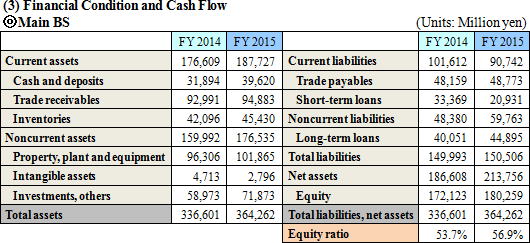 Total liabilities were ¥150.5 billion, up ¥0.5 billion, due to decrease in short-term loans and increase in long-term loans. Net assets were ¥213.7 billion, up ¥27.1 billion YoY, as a result of increase in retained earnings and foreign currency translation adjustment due to depreciation of yen. Equity ratio was 56.9%, up 3.2 points from 53.7% at the end of the previous term.  The minus territory of investment CF became smaller because there was no expenditure for acquiring affiliates, associated with changes in the scope of consolidation in the previous term, even though expenditure increased as a result of acquiring property, plant and equipment and securities. As a result, the positive territory of free CF also expanded. The minus territory of financing CF has expanded due to decrease in short-term loans and decrease in earnings from long-term loans. Cash position became stronger. |
| Fiscal Year March 2016 Earnings Estimate |
 An increase in both sales and profit is expected.
Sales are estimated to be ¥300 billion, up 4.6% from the previous FY. Sales are expected to increase in all segments. Operating income is estimated to be ¥20 billion, up 9.8% YoY. Effect of increasing quantity as a result of increased demands in the overseas ink market and sales strengthening efforts in new locations (¥1.8 billion), raw material price drop effect (¥1.0 billion), and foreign exchange effect (¥ 0.8 billion) will exceed decrease in sales of high performance products (-¥1.0 billion) and increase in fixed costs (-¥0.9 billion). Except for the colorant and functional materials segments, double-digit increase in profit is expected. Dividend is estimated to be ¥15.00/share, up ¥0.50/share. Forecasted dividend payout ratio is 37.3%. The Group's three management principles of this FY are as follows: 1. Strive to launch innovations constantly and enhance marketing capabilities.
2. Strengthen global networks from both offensive and defensive perspectives. 3. Seek to enhance the value of management resources as well as group companies. 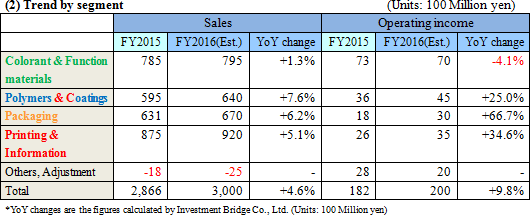 ☆Colorants and Functional Materials Related Business
This segment is expected to record an increase in sales and a decrease in profit. The theme is "to create a business model following the color filter business". Priority actions for this segment are: 1) creation of new products, new materials and new business models, 2) improved revenue as a result of production process reform and business model reform, and 3) improved competitiveness by accelerating development speed. The LCD market is expected to continue increasing by about 5% during the current FY. In line with this, the Company will expand the range of utilization purposes of the display materials as well as shift management resources to keep pace with the growth of Chinese market. ☆Polymers & Coatings Related Business
This segment is expected to record an increase in both sales and profit. The theme is "to expand sales of three pillars of the growth strategy, that is, high-value-added products in the fields of: 1) electronics, 2) energy and 3) healthcare". Priority actions for this segment are 1) promotion of growth strategy, and 2) strengthening business foundation. The Company will expand its business fields into downstream market, strengthen global supply chain management (SCM) and globally expand its technology network. It will focus on the sales expansion of electromagnetic shielding films, optic film related products and UV products. ☆Packaging Materials Related Business
This segment is expected to record an increase in both sales and profit. The theme is "to respond to the increasing package demand in newly emerging countries". Priority actions are 1) strengthening sales, and 2) strengthening business foundation. The Company will try to strengthen sales of gravure inks in Asia, mainly in China and India, and improve operation rate through business expansion of new overseas locations in China and Brazil. In Japan, the Company will aim to expand the market share of eco-friendly high performance laminate inks as well as inks for surface printing. ☆Printing & Information Related Business
This segment is expected to record an increase in both sales and profit. The theme is "to strengthen sales capabilities and operation rates in the new locations". Priority actions for this segment are: 1) strengthening sales, and 2) strengthening business foundation. The Company will expand its business in India and Brazil and standardize production process to respond to the needs of global production. Even though the domestic market is expected to continue to shrink, the Company will aim to expand the sales of new inks for sheet printing (*) and supersensitive UV inks. It will also strengthen its marketing activities in the new markets of Turkey and Central Asia. *Inks for sheet printing: Inks to be used for sheet printing where sheet papers, which are detached one by one, are set on a printing machine. |
| Growth Strategies |
|
(1) Midterm Business Management Plan, SCC-III
The Midterm Business Management Plan, called Science Company Change (SCC), began in April 2008. In April 2014, its 3rd term, "SCC-III Evolution Plan" for April 2014 to March 2017 began.
 ◎ Business domains and technology platforms
In the SCC-III, the Company is aiming to "transform from Specialty Chemical Manufacturer to a Science Company" and established 3 business domains and 5 technology platforms. Through collaboration between the "Group Technology Center", which is the laboratory facility of the Holdings, and business departments of each group company in Japan and overseas, the Group will carry out basic research and product development.
<Business Domain>
Each business domain sets priority areas and will continuously develop and offer products that respond to the changing tide and market needs. Although the progress thus far is uneven, development of secondary battery related parts in the "Sustainability Science" domain reportedly started showing good results from this FY.
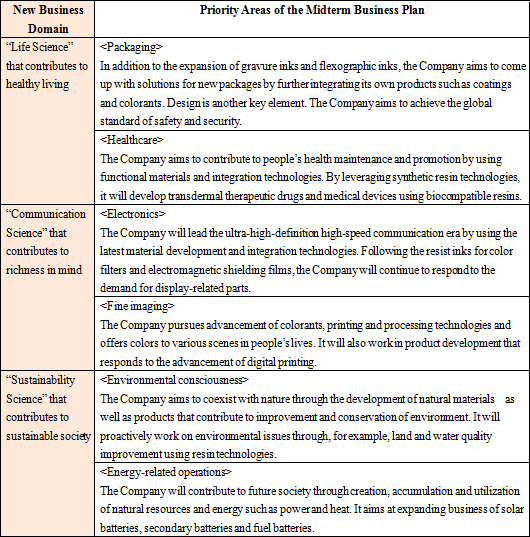 <Expansion of Technology Platform (TPF)>
Technology platform refers to technology accumulation and basic technologies that will be the basis and foundation for developing new products. The Company initially had three conventional TPFs: 1) "Specialty Materials" that advance existing materials to special materials, 2) "Material Processing" that adds functions and values with unique processing technologies to specialty materials, and 3) "Converting Components" that process materials to meet diversifying and advancing needs. Then Company added two more TPFs. One is "Module Designing," which is a technology for examining products from customers' point of view and reflecting the results in the downstream expansion of products and development of new products. The other is "Solution," which is aimed at creating products that are valuable for the users by proposing design and formation. Thus the Company has a total of five TPFs. 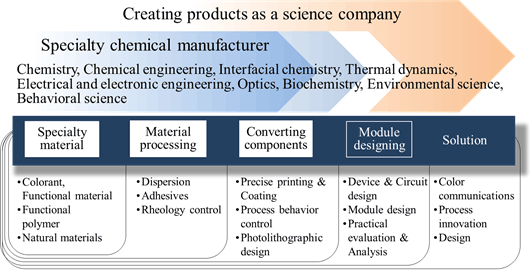 ◎ Plans for each business segment
The Company aims to expand its four business segments in a well-balanced manner. The potential growth of "Colorants and Functional Materials Related Business" with a focus on LCD color filter, which occupies about 40% of the current operating income, is high but subject to economic trends. Printing inks, on the other hand, can expect little of their market growth, but they are less likely to be affected by the changing economic environment. The Company will pursue market development in newly emerging countries based on the principle of "local production for local consumption" to obtain stable income base for the "Printing and Information Related Business" and "Packaging Materials Related Business" segments. At the same time, it will pursue growth by developing and selling new high-value-added products for the "Colorants and Functional Materials Related Business" and "Polymers and Coatings Related Business" segments. 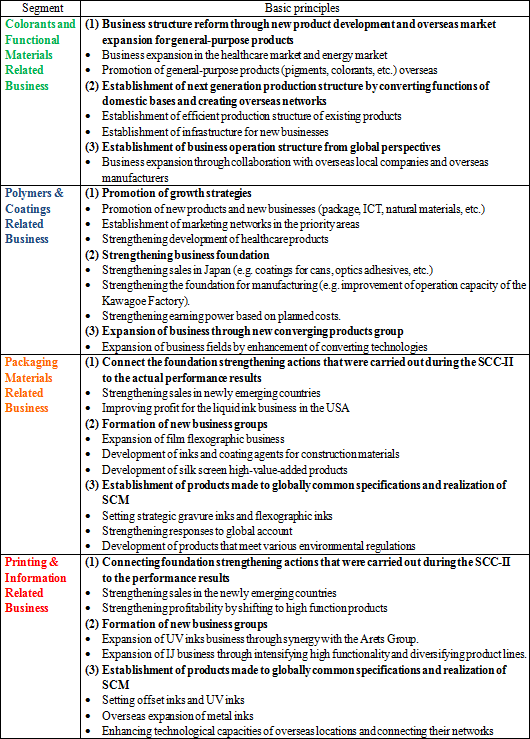 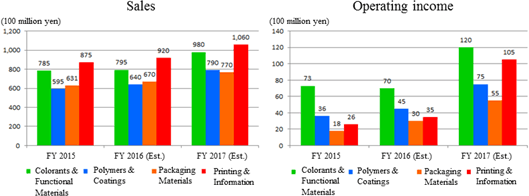 ◎ Overseas expansion
The goal of SCC-III for the overseas sales ratio is 50% (it was 43% during FY 2015).The local manufacturing structure of printing inks in India and Brazil has been almost completed during the previous Medium Term Plan. From this FY on, the Company is planning to accelerate increase in production amount and strengthen production and sales of adhesives in Asia and the United States for diversification. Furthermore, in an effort to explore new markets, the Company will also work on marketing in Mekong Basin area and Mexico and strengthen sales in Turkey for the possible future local production. In the market of emerging counties, the Company will make efforts to expand sales by selling high-spec products just like the ones sold in Japan, as well as lowering costs of the Company's unique middle-spec products that are high quality and eco-friendly. In developed countries, the Company will make efforts to expand sales of UV inks, which is the Company's strength, taking advantage of growing number of Japanese printing machinery sold in Europe and the U.S. The UV inks for packaging made by Arets International NV (current Toyo Aretz International NV), which was acquired by the Company in April 2013, will also be strong weapon for the Company. ◎ Strengthening management foundation
In addition to the above-mentioned actions to expand the business, the Company is making efforts to strengthen management base through "strengthening the manufacturing base" with a focus on cost reduction, "promotion of environmental management" to reduce CO2 emission, "development and utilization of human resources" by expanding diversity, and "streamlining management" by introducing integrated systems on a global scale.
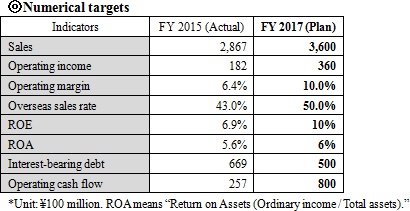 (2) Message from the Company to the investors
As stated in our management philosophy, we Toyo Ink, a lifestyle creating company, is always aiming to develop products from the consumers' perspective.Even if you have never heard of our name, we would like you to know that our products are used in various situations in your life. Not as a mere ink manufacturer but as a science company, we will continue looking towards the client companies' future and plan to expand the range of products that are essential to the society. We added "improving shareholders' value" last year in its Guiding Principle, and are successfully changing the corporate minds and the mind of employees. We would like our investors to see our steady growth through new product development and overseas expansion, and seek support from our investors from mid- to long-term perspectives. |
| Conclusions |
|
It is certainly hard to expect a large growth in the Japanese market in the field of "Printing"; however, this is a market where we can still secure stable profit by expanding the market share with the products' values and capability to propose technology. Furthermore, overseas, especially in emerging countries, one can say that printing on food packaging is expected to grow as living standards there are rising. It is true that investors are expecting to see higher growth. One of the causes of low PER and PBR may also be the Company's business structure in which about 40% of operating income derives from the colorants and functional material segment. Under such circumstances, development of new sources of earnings next to LCD color filter materials, especially expansion of overseas sales and development of the energy and healthcare products by leveraging the Company's materials and technological skills, is the key point of interest. Disclaimer
This report is intended solely for information purposes, and is not intended as a solicitation to invest in the shares of this company. The information and opinions contained within this report are based on data made publicly available by the Company, and comes from sources that we judge to be reliable. However we cannot guarantee the accuracy or completeness of the data. This report is not a guarantee of the accuracy, completeness or validity of said information and or opinions, nor do we bear any responsibility for the same. All rights pertaining to this report belong to Investment Bridge Co., Ltd., which may change the contents thereof at any time without prior notice. All investment decisions are the responsibility of the individual and should be made only after proper consideration.Copyright(C) 2015 Investment Bridge Co., Ltd. All Rights Reserved. |

